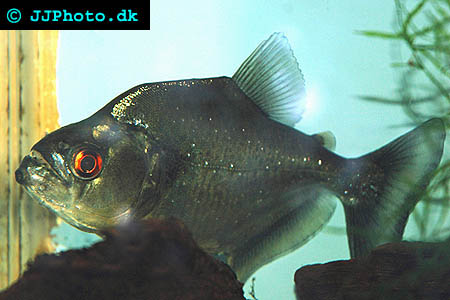(note: The correct spelling is Piranha but we have chosen not to edit the article since we have been unable to reach the author who sent us this article to get permission to do so)
The name Pirhana is in reality used for a large number of species in the sub family Serrasalminae. This makes it hard to create a accurate guide about how to care for all Pirhanas since different species has different needs. This guide will focus on the most commonly available and most popular Pirhana species, Pygocentrus nattereri, the Red Belly Pirhana. If you are considering getting any other species of Pirhana I strongly recommend that you read up on that particular species before joining the Pirhana owners clubs.
Red Belly Pirhanas can live for more then 20 years and grow to a size of 18 inches / 45 cm. They should like all other Pirhanas be kept in schools of no less than 6 or better 10 fish. This means that you will need a large aquarium to be able to host them as they grow. An aquarium with a volume of at least 50 gallons (200 L) is a requirement for young Pirhanas and a school of adult Pirhanas requires a much larger aquarium than that.
Red Belly Pirhanas eat a lot which put a lot of stress on the water which means that good filtration and large regular water changes are a necessity to keep the water quality up adds your Pirhanas healthy. The water temperature should be 75 -80°F / 24-27°C. Pirhanas do better in soft water with low mineral levels.
The aquarium should be decorated so that the fishes have hiding places and a lot of free swimming space. Young fishes will leave plants alone and prefer a planted aquarium while plants aren’t a requirement for more mature Pirhanas. Young fish can be kept with other species. Adult Pirhanas are best kept in an aquarium with other Pirhanas of the same species. Pirhanas can sometimes be kept with other fishes without touching them but this is not a guarantee that the fish will be safe with the Pirhanas in the future and it is therefore best to never take any chances with other fishes in a Pirhana aquarium.

Picture of a black piranha - S. rhombeus. Copyright www.jjphoto.dk
Pirhanas can be feed flake food and pellets while they are young but will need more meaty food as they grow older. More mature fish should be feed low fat meat such as beef, fish pieces and live feeder fish. They should be feed several times a day while young while one time a day is enough for adult fish.
Pirhanas has a bad reputation as being dangerous and for taking bites out of their owners but the risk for being bitten out injured by Pirhanas in aquariums are very low as long as you feed your Pirhanas. Underfeed (read starving) Pirhanas might bite. Pirhana attacks are very rare in their natural habitat.
Please note that Pirhanas are illegal in the state of California.



